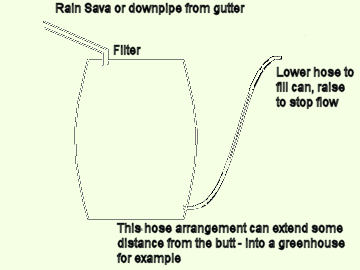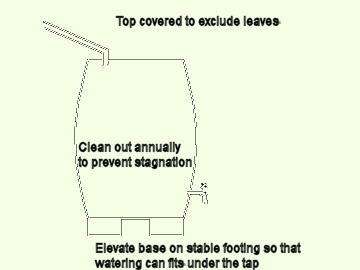Bonsai masters widely accept this skill as being one of the most difficult to learn. Too much water tends to rot the fine feeder roots and too little dries them out. One thing is certain, if you don't get it right you will certainly harm and possibly kill your trees.
The reasons for this apparently simple task being so tricky, are manifold:-Different species have different requirements. e.g. Willows and Alders require a constant supply, Pines need to be kept much more on the dry side.
Trial and error is not the best way to learn. Reading up the needs for each species is the only way to ensure success. The size of container and nature of the soil also help determine how quickly the water supplied drains away, is evaporated or is used up. A large, deep pot containing compost with a high humus level or other absorbent materials such as perlite, hortisorb, biosorb or seramis will retain moisture for longer. A shallow pot or slab with gritty soil and little humus dries much more rapidly.
Trees require differing amounts of moisture at different times of year. This is not only due to rate of growth. Hot sunny weather increases the transpiration rate from the leaves and the tree demands more water. Add drying winds to warm weather and the need for watering is further increased. Pots that are in shaded or sheltered positions will require less than those in sunlit, exposed and windswept ones. Be particularly careful with any small trees that are tucked away behind others. They may be too easily neglected and it is wisest to move them to a more obvious location.
Determining Need
Once you get to know your own trees and their soils, the watering routine soon becomes less daunting. You can visually check the condition of the compost on the surface but it is far more effective to probe just under the soil level with a finger. One of the most effective ways is to leave a short length of chopstick pushed into the soil. Remove it to check how damp the compost is. Instinct kicks in after a while, so that the regularity of checking will adapt itself to the prevailing weather conditions and the needs of your own particular trees.
Trees in the smallest mame pots may need watering so often in the summer that it can become almost impossible to keep them alive. It's a good idea to stand small trees on a humidity tray filled with pebbles and a shallow layer of water. Another useful trick is to keep them all in a seed tray, with drainage holes, filled with damp sand, coir, leafmould or chipped bark etc. This will hold a reservoir of moisture beneath and around the pots, keep the atmosphere more humid and still allow good drainage. The roots will tend to spread out into the surrounding moisture reservoir and they require frequent cutting back.
Note that it is essential that most trees are not standing in water or a waterlogged reservoir. Dampness but not sogginess is the best way I can describe it. Only a few tree species can survive or thrive when waterlogged. Willow, Alder, Swamp Cypress and Wisteria all like more than average quantities and it helps to stand them in a water filled tray in summer.
Any plant that wilts should be suspected not just of lack of water. Root rot and Vine Weevil grubs can also be a cause, so check the roots first. Adding water to a plant with root rot will ensure its death.
The Right Tool

Any watering can with a long, narrow spout will suffice, but purchasing the best that you can afford is sensible. The tools that you use are an extension of your hobby and design quality brings with it an element of satisfaction in use. If a fine rose is fitted, facing upward, this helps to achieve an even sprinkling action which avoids blasting compost off the surface of pots.
 fine rose sprinkling (click image for a close-up) fine rose sprinkling (click image for a close-up)
The three gallon can is too heavy for most bonsai jobs. A two gallon one is bearable for a short time. Smaller ones are much better for mame and shohin trees. Trees should have water sprinkled all over the surface of the compost until water is noted coming from the drainage hole. Water the other trees and then repeat from the start. This second wetting helps to ensure that any parts of the pot that didn't soak up water the first time will have become slightly damp and more able to readily absorb it on the second pass. It also helps to drive stale air out and sucks fresh air in. This is essential for healthy growth. A hose end sprinkler is a boon for speeding up watering a large collection. The sort sold for dispensing soluble fertiliser can also be used as a wide spray watering device.
WATER QUALITY
Having used great care with the growing medium that trees are grown in, many people take the quality of the water that they use for granted. If it comes out of the tap it must be pure and therefore suitable, mustn't it? Not necessarily. The chemicals that are added to water prior to its distribution may include any or all of:- Chlorine to kill off germs, fluoride for healthy teeth, and sodium hydroxide to alleviate the acidity of water and prevent the lead in older water pipes being attacked. There may also be permitted levels of a variety of residual chemicals.The cumulative effect that all the above can have on trees, when used constantly with no rain to wash away the build up, can be damaging, if not disastrous.
Tap water should be stood overnight in a water butt or the watering can. Most of the chemicals contained are volatile and will evaporate, or at least diminish. It's temperature will also approach that of the air and this has long been known by gardeners to be beneficial to the growth of plants. Standing does not reduce water hardness though.
Water supplies can change over time. Even if you know that your water is relatively pure and you are aware of its pH, this can be altered overnight by the water supply company and they are not yet duty-bound to inform you. Sources of water can be swapped from one river or reservoir to another. New sources of water are constantly being sought and brought on line to satisfy the increasing demand and alleviate the effects of droughts; Artesian water from deep underground, water piped in from other more distant reservoirs, using canals to move water to areas where it is needed, there has even been discussion of water being imported, through pipes in the Channel Tunnel, from France!
I have had personal experience of water supply alteration. Much to my disgust, the beautifully flavoured, soft peaty water from local moorland reservoirs was swapped and we then received water from an artesian (underground) source in a limestone area. Had I not noticed the change in flavour and taken the precaution of pH testing, immense damage could have been done to my lime-hating plants (Satsuki azaleas, Rhododendron etc).In areas where tap water is hard, growers observe lime-scale (whitish deposits) on pots, tree roots and even on the surface of akadama granules in the soil mix.It is only common sense therefore, to always be aware of your water quality, or even to provide your own special supply for plants.
Storing Rainwater
Bearing water conservation and the potential for problems with tap water in mind, it is a great idea to utilise rainwater. The incentive to do this is even stronger if your tap water is metered. Rainwater generally flows off roofs, down drainpipes and is carried through drains either to rivers or to water treatment works. It is a fairly simple matter to interrupt this cycle and keep some of what is yours for free.

Locate your water butt as near as possible to the trees requiring the most water. Any roof area that has a downpipe can be used to keep the tank filled. In most parts of Britain even a small greenhouse roof will supply water for most of the year, for a few trees. If a downpipe on the house is used, connect the butt using a device that allows water to fill the tank and then returns excess water to the drain. Raising the butt on a stable base or foundation of some sort is advisable. This should prevent its weight causing it to sink/topple and allows a watering can to be placed under the tap. If the tap is too low a simple temporary fix is to attach a short length of hose to it and use this to fill your can.

Remember to clean out the butt every year or two, as leaves, moss and lichen are washed in from the roof. They will eventually build a deep enough layer to block the tap or begin anaerobic rotting, producing nasty smells and polluted water. Common sense and the application of these guidelines should ensure that your plants remain well watered and healthy. Get the fundamental skill of watering mastered and you will be well on the way to a long and successful growing pastime.
All Text, Diagrams & Photographs © Kevin Bailey 1998 - 2008
|

